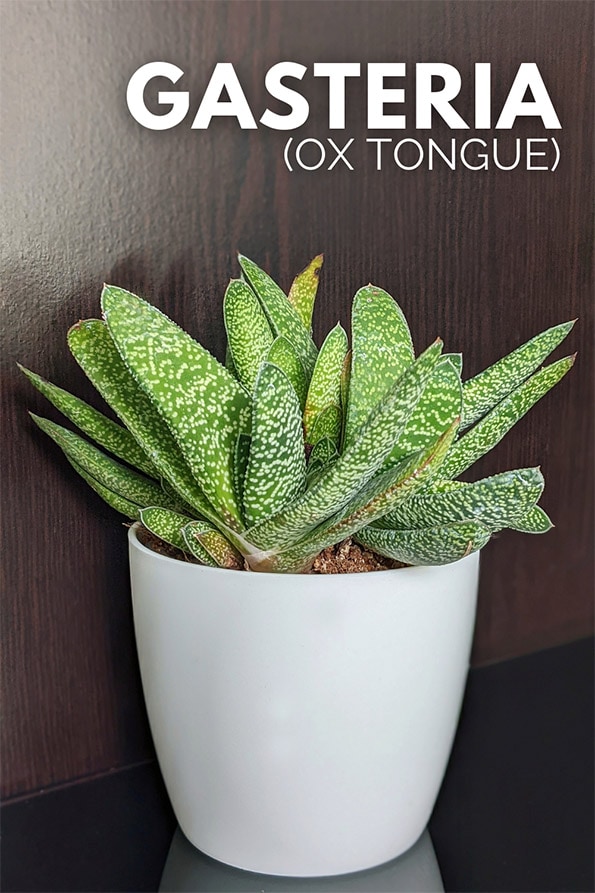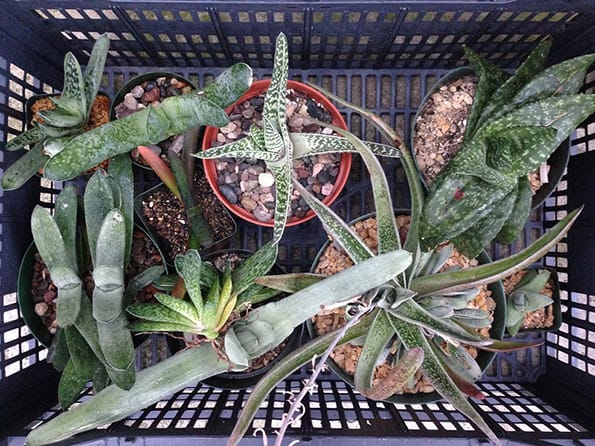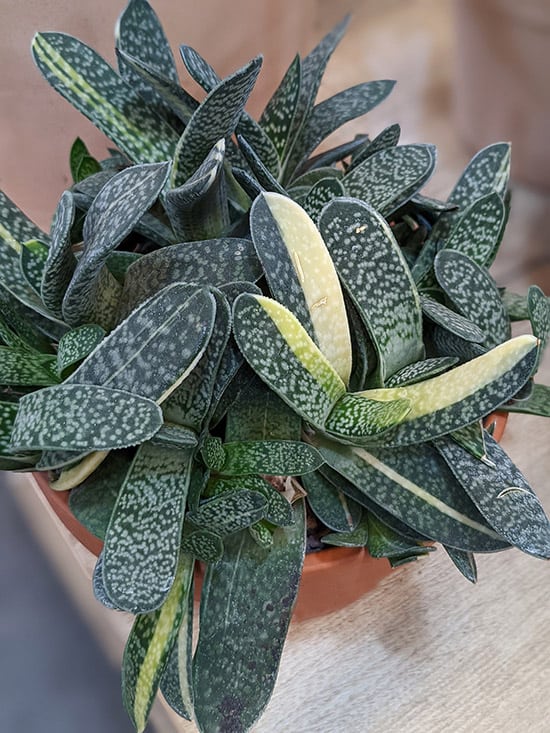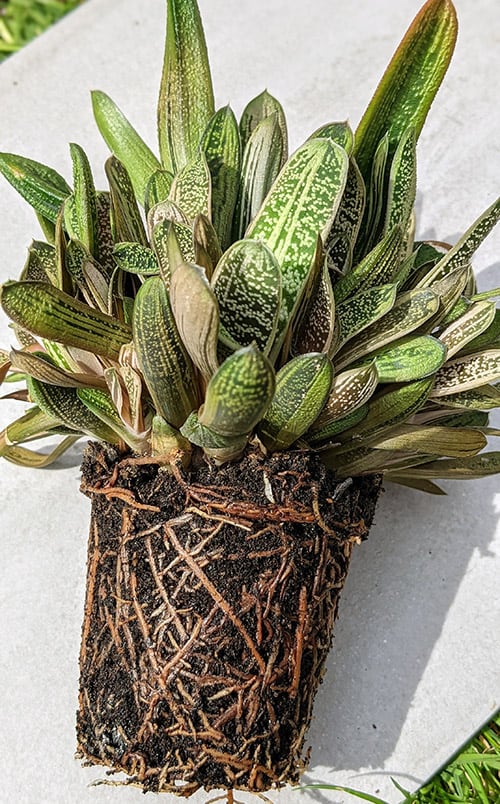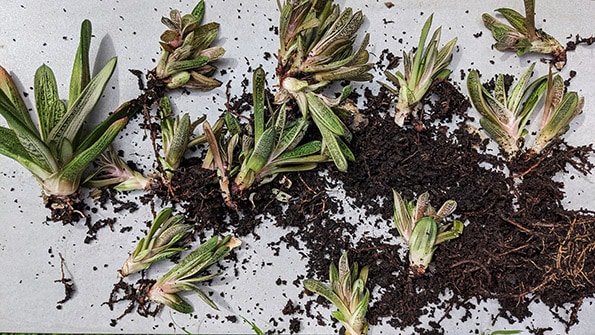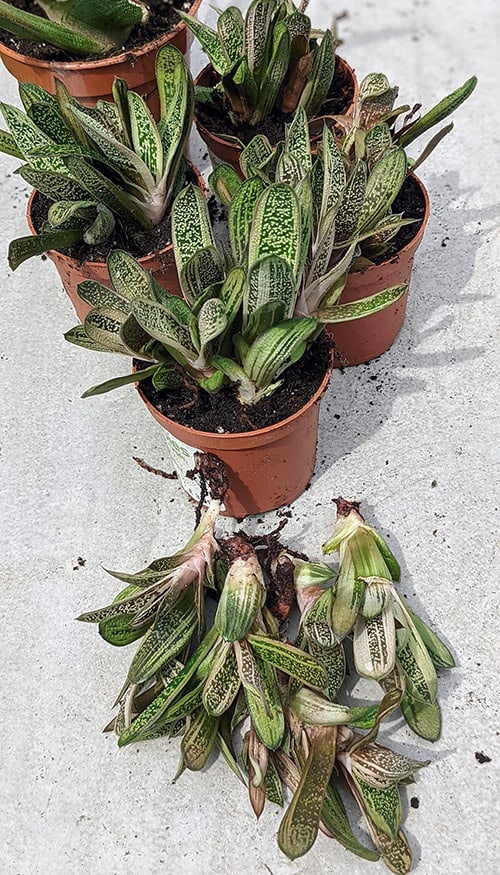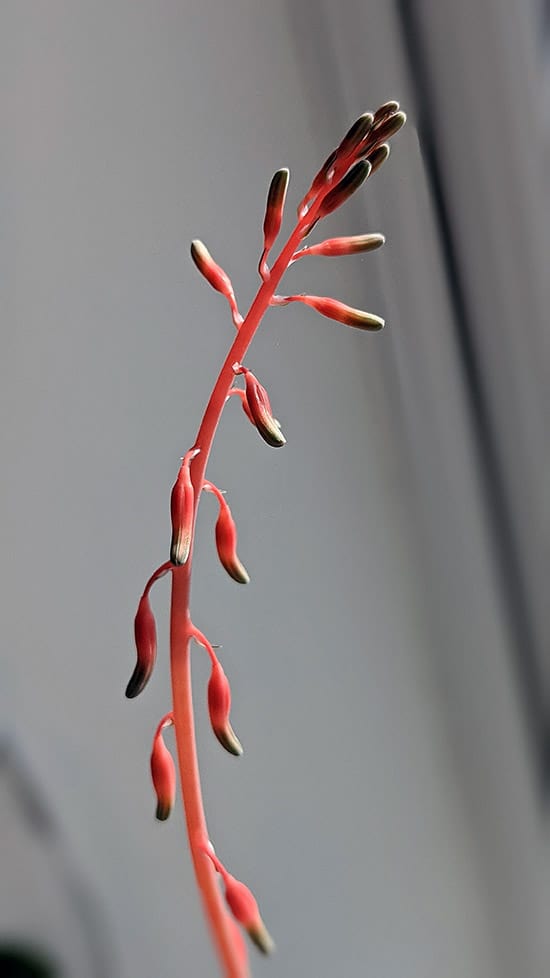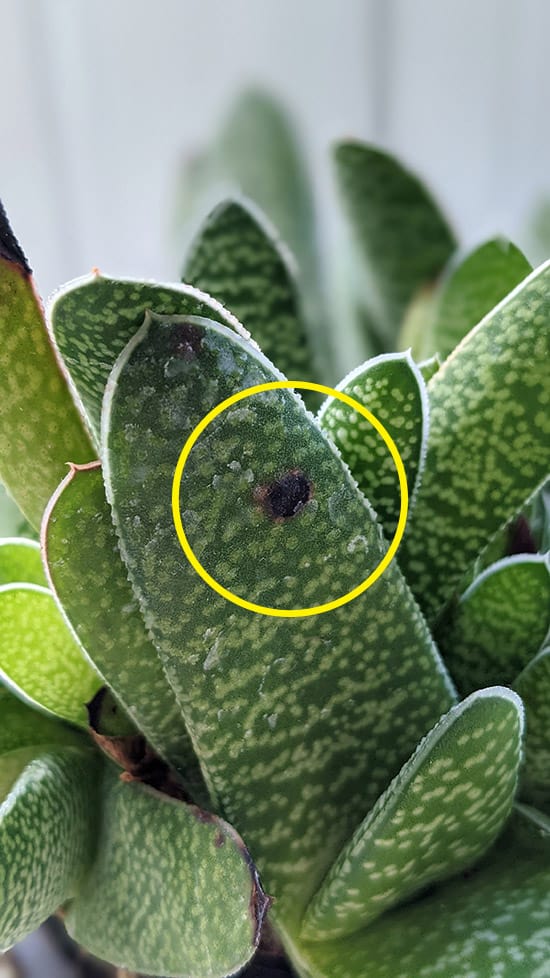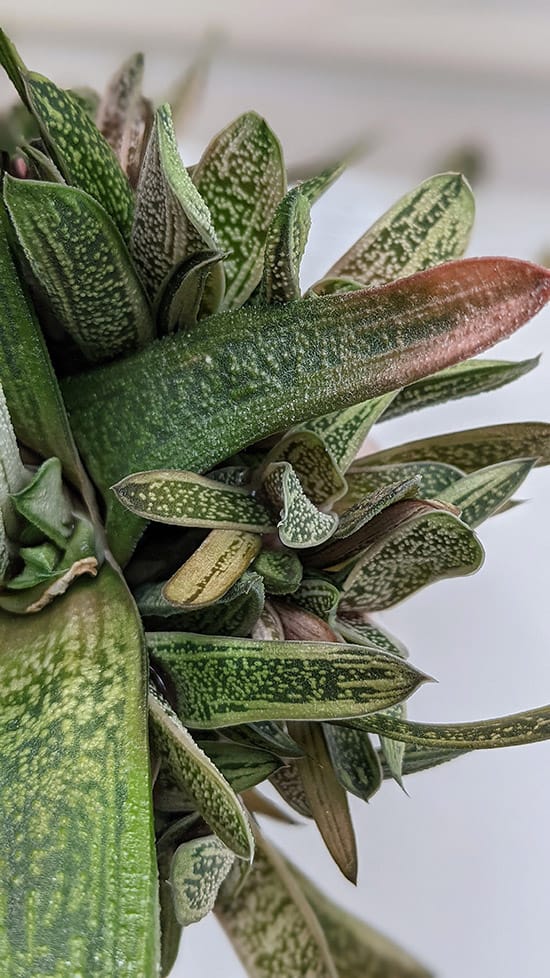Gasteria are small succulents with thick fleshy leaves covered in small white dots that often give them a rough texture. They sometimes go by their common name of Ox Tongue plants because of their tongue-shaped leaves.
These easy plants are in the same family as Aloes and Hawthorias. In fact they're so closely related they can pollinate one another, creating unusual hybrids in the process.
Grown as a houseplant they're super easy to own, fairly adaptable to different locations around the home or office and only need simple care. This article will tell you what you need to know about these unusual houseplants including, how to care for them.
Like most Ox Tongue Plants, Gasteria pillansii has a strong architectural shape and is pleasing to the eye.
Its native habitat is the Eastern Cape Province in South Africa, so it's adaptable to a reasonably changeable climate. This makes Gasteria's good houseplants for a wide range of homes. They don't grow particularly fast or very tall and their striking appearance makes them ideal gifts and quirky indoor plants.
How do you pronounce Gasteria correctly? Say:
Gas-TEER-ee-uh
Well cared for plants might produce flowers in early Spring and if you want to create more, then propagation is easy through leaf cuttings or division and has a high rate of success.
You can put them outside in the summer and treat them like outdoor succulent plants or keep them inside all year round as an indoor plant.
As mentioned earlier, Gasteria can be crossed with Aloe plants and Hawthorias, and so there are multiple hybrids around, including many true Gasteria species. This means there are a LOT of different looking plants out there.
Common Names
Many people will call these plants "Gasteria", but it also goes by a few other names of Ox Tongue, Cow Tongue and Lawyers Tongue.
The "tongue" naming comes from the leaf's shape and thick, coarse texture.
Over here in the UK, I'll often see Gasteria pillansii, Gasteria minima and Gasteria Little Warty for sale and a handful of others which I think are Gasteria acinacifolia, and gasteria carinata.
The problem is that growing conditions and age can all affect how the plant looks. So it can be challenging to work out what species or named variety you actually own. Not an expert by any means, but if you have a "no ID" plant, you're welcome to put up a photo in the comments and we can try and work it out together.
Gasteraloe 'Green Ice' is a popular hybrid cross between Gasteria and Aloe. Several are also being cultivated with yellow variegation for a splash of additional interest. If you're into these plants and collecting them, it's a pretty exciting time.
There are close to 100 different varieties. Here are just a handful of gasteria succulents - Photo taken by Reggie1
The photo above shows some of the variations on offer. Ten very different looking plants, all Gasteria's!

Hi, I'm Tom!
If you're like me and enjoy the challenge of growing houseplants and getting them to thrive, then Ourhouseplants can help. This website shares my knowledge and years of growing plants and provides (hopefully) helpful advice on properly caring for your indoor plant friends.
These are weird plants when it comes to light requirements. They can cope with a broad range, but allowing some time for them to adapt is essential. Plants grown in shady spots then suddenly moved to a sun drenched window, will quickly get unattractive red and maroon leaves.
On the other hand, my dad had his growing in a dark hallway, 15ft away from a small glazed window where even Peace Lillies struggled. I kept telling him to move it, but it took him over a year to do so. The plant survived and actually looked perfectly fine.
I don't recommend following my dad's example, especially if you actually want yours to grow! They're looking for bright light, some full sun is okay too. Be warned that any direct sunlight from around 11am to 3pm will probably be too harsh and again you'll get the red leaf issue.
How much water in Winter?
Some people will put their plants into an unheated porch or conservatory over winter to give them a "rest".
It's not essential to do this and the temperature in these places shouldn't go lower than 5°C (41°F) (they're not frost hardy!). If you do this, they won't need any water over the Winter months.
These are succulent plants, so this means they're excellent at conserving water and coping with relatively long periods between waterings.
I'd describe these plants as being one of the best at doing this. Not as good as cacti, but better than Euphorias like the African Milk Tree. So they make super plants for holiday homes or people who travel and might be away for weeks at a time.
What they really want from you, is a good soaking and then being allowed to dry out. Once this happens, water again.
How often you do this will depend on your environmental conditions. i.e. warmer spots in your home with lots of light will mean more water is needed than those in colder areas with more shade.
More than once a week is likely overdoing it and isn't a typical watering requirement for these plants.
Whatever your humidity level in your home, they should be able to deal with it. Low humidity is not a problem for these plants. The only issue you might have is in highly humid environments, which, if combined with overwatering, can be a trigger for fungal infections and eventually root rot.
In general, slow-growing plants like these don't need much feed, and giving lots won't make them grow any faster. A houseplant or succulent based liquid fertilizer once every three months is enough.
Gasteria minima 'variegata' - Considered rare, so it can be expensive compared to many Gasteria's.
You can grow it somewhere with a warm temperature all year round. A range between 17°C (62°F) and 25°C (77°F) is ideal. They will adapt to higher temperatures during warmer weather, but you may find they stop growing when it's too hot for them.
They're not frosty hardy though and will rot or become damaged if they're exposed to cold temperatures, so bring them into the warm before Winter arrives.
Some owners swear that giving them a rest over winter boosts them in the following growing season. Doing it is optional, but if you do, your plant needs to go somewhere with lower light levels and a cooler temperature that doesn't go below 5°C (41°F).
A Gasteria plant can live in the same small pot for years and still do pretty well. However, when you notice there is no further growth, or you want them to spread outwards, but there is no space to do so, then it's time to repot them.
Tell Me More
If you want to learn more I cover the reasons Gasteria stops growing when in a small container, in my "do succulents like small pots?" article.
Theoretically, you can repot at any point during the year. Still, the best time is in Spring or Summer as warmer conditions will help to compensate for any mistakes with giving too much water to a plant in the new larger container. The plant will be using more water, and the warmth will dry out the potting medium quicker.
A pot with drainage holes is pretty much essential. If you don't have at least one drainage hole in your pot, I'd suggest moving your plant over to one that does. Failing that, 10 minutes after watering, turn the container so any water not absorbed by the growing medium can be drained out.
The root systems of these plants are pretty adaptable. They can cope with a range of potting soils or growing mediums, from typical everyday houseplant soil or more specialized succulent mixes including some more sandy soils.
I like mine to be as free draining as possible to reduce the risk of root rot or overwatering issues. This means I'll add some grit or Perlite to the growing medium to help.
I talk about this a lot I know, but I really recommend coconut coir. It holds water well, but never seems to compact and helps keep the structure open and more airy than heavily based peat products.
Gasteria are primarily clump forming plants. Over a few years this means offsets will keep growing out of the sides and edges of the "mother" plant. There will be considerable additional small plantlets in time, all growing in the same pot.
Like many succulents you can propagate by a single leaf cutting. But the easiest way to propagate new plants is to divide and remove these offsets and either grow them on as individual plants or in smaller groups.
This parent plant is surrounded by young plants ready to be separated.
The plant above is heavily congested with offsets. The pot was literally full to the brim with them and as you can see, the root system from all this growth is pretty extensive. It's prime propagation material to create lots of new plants.
Firstly the bad news. Sometimes they don't break up easily is all I'm going to say!
To give new plants the best chance of making it, it's normally best to remove offsets with some of their roots still attached. You might be able to do that with a plant with just a handful of offsets, but it's not going to happen when you have many, like the plant in the photo.
You just have to bite the bullet and break them apart as gently as possible with your hands and hope for the best.
You can divide them with a sharp knife, but sometimes using your hands and fingers is more straightforward.
As you can see, most of the offsets (and even the mother plant on the far left) have very few roots attached. It's not ideal, but they will recover and grow replacement roots soon enough, providing the base of the plant is intact. Fortunately, almost all of these were.
You can leave them to "dry" for a few days and let any wounds callous over before doing the next step, but I'm doing this during the early Summer months. It's warm, plenty of light and as I have so many, I'm happy to risk it.
Push the offsets slightly below the soil surface to hold them in place. Then just a little water until they're adequately established.
All you need to do, is pot them up into smaller pots. I've put two or three offsets into each new pot (because I had so many) and still have a good 10 offsets to go!
All you do next is put them somewhere similar to where they were, before being divided from the mother plant and in a few weeks, new roots should be forming. They might not all "take," but if any don't and start to go rotten, I'll remove them and discard.
Watch our short YouTube video if you want a visual propagation guide.
Most varieties are quite small, and they don't grow too quickly. When considering their size, I'd still class their growth as moderate with a few new leaves forming every couple of months.
They will typically spread outwards in their pots by the offsets, and they tend not to be overly tall. The ultimate height will depend on the Gasteria variety you have, they can range from 2.5cm / 1 inch up to 15cm / 6 inches. The flowering stem gives considerably more height though! (See below).
Did You Know?
"Gaster" from "Gasteria" is Latin for "stomach". That might sound like a weird naming choice for this plant, until you look at the shape of the flowers. They're stomach shaped!
After a few years it's normal for a Gasteria (or its cluster) to produce a flowering red stem or two, called an Inflorescence. This is typically extremely long in comparison to the small size of the plant.
The flower spikes will grow upwards, bending towards the light as they go (rotate your pot every few days if you want it to grow straight up). Blooms will appear on the top couple of inches and they last for several weeks.
None of the varieties I've grown have flowers that are scented and they all seem to flower around March, April or May. I've read reports that you can get a second flush later in the year, but my experience is that they only do it once a year.
A Gasteria blooms and shows off its red flower stem.
Once the blooms have faded the inflorescence quickly starts to brown and the flowers fall off. You can just cut it off as close to the base as possible when the display is over.
Gasteria are safe to have around your cats, dogs and other pets.
Black Spot
One of the two very common issues with Gasteria are black spots appearing in random places on the leaves as shown in the following picture.
Although they're low maintenance plants, the fleshy leaves are easily damaged.
Although it's considered a natural defense mechanism, there are two reason why this might be happening.
Thinner and flat leaves
Usually, the leaves should be quite plump, but there seems to be three things that eventually cause them to become flatter and have that leathery texture. They could all be happening or just one or two of them.
Red Leaves
This is the second most common issue with Gasteria, when the normally green leaves start going red or dark maroon.
Red leaves can be a sign of too much bright sunlight. Pull it back into light shade and the red will eventually fade.
Root Rot.
Overwatering is the main problem with this plant, everything else can be dealt with, but too much water, too often and not letting the growing medium dry out in-between will eventually lead to fungal issues setting in.
When this happens, bacteria and fungi can easily colonise around the roots and then the lower parts of the plant. Before long the whole plant will get soggy and mushy.
However, it's not necessarily time to throw your plant on the compost heap. Even if all the roots are gone, it can regenerate with some tender loving care as long as the base is intact.
Get some fresh potting soil (if you're prone to overwatering, add in some coarse sand or similar to try and stop so much water being held in the potting mix going forward) and gently push your Gasteria into it. Just enough so the base is in contact with the soil.
Keep the soil barely moist and in a few months all being well, new roots will have formed and established. Congrats, problem averted and you've saved your Ox Tongue houseplant!
Credit for the photo of large pot with several plants / The three different Gasteria on show / Large number of plants in a shopping basket Reggie1
